Mark Sisson's Blog, page 254
July 27, 2015
Dear Mark: Budgeting, Calcium, Supplements, High Cholesterol, and Chinup Replacements
 For today’s edition of Dear Mark, I’m answering five questions, all coming from a single reader email. First, Rosa asks about buying high-quality produce and grass-fed meat for her family on a budget. Can it be done? If not, what should she do? Second, she wonders whether she’ll get enough calcium eating this way. It’s a valid concern, seeing as how basic Primal eating often eliminates dairy. I try to assuage her. Third, if the Primal Blueprint is such a healthy, nutrient-replete lifestyle, why do I sell supplements? How does one reconcile the two seemingly contradictory concepts? Fourth, should Rosa be worrying about eating a high-fat diet if she’s taking meds for high cholesterol? And fifth, what are some effective replacements for chinups and pullups that can be done at home sans equipment?
For today’s edition of Dear Mark, I’m answering five questions, all coming from a single reader email. First, Rosa asks about buying high-quality produce and grass-fed meat for her family on a budget. Can it be done? If not, what should she do? Second, she wonders whether she’ll get enough calcium eating this way. It’s a valid concern, seeing as how basic Primal eating often eliminates dairy. I try to assuage her. Third, if the Primal Blueprint is such a healthy, nutrient-replete lifestyle, why do I sell supplements? How does one reconcile the two seemingly contradictory concepts? Fourth, should Rosa be worrying about eating a high-fat diet if she’s taking meds for high cholesterol? And fifth, what are some effective replacements for chinups and pullups that can be done at home sans equipment?
Let’s go:
Hi,
I’ve been reading The Primal Blueprint and am very interested but I have a few questions :
– I have a family and am on a budget which makes it hard for me to purchase organic foods and grass-fed meats. What do you recommend I do to get the same benefits? I can buy lean meat at regular grocery stores but it’s not organic nor grass-fed.
– What about calcium? Will I be getting enough calcium?
– I notice you sell supplements. If we follow the program, I thought we are getting all the vitamins and minerals we need. Who would be needing these supplements and how do we know if we need them?
– I have high cholesterol and am taking medication. I’m so afraid to eat more fats as suggested in the Blueprint. And if I end up eating some carbs or cheating one day, won’t this fat end up being bad for me? How do I overcome this fear?
– In the fitness program, I don’t have anything around the home to do chin ups, what do I do?
Thank you in advance for replying. I appreciate it!
Thank you,
Rosa
Thanks for the questions, Rosa. Let me address each in turn.
Budget
Hunt around for sales and stock up whenever something good (organic/grass-fed) reaches a price that works for you. Store in the freezer. Wrap tightly in freezer-safe ziploc bags, making sure to suck out all the air to prevent, or at least limit, freezer burn.
Keep your eyes out for Australian or New Zealand lamb (the former is usually pastured if not entirely grass-fed and the latter is almost always grass-fed). Uruguyan, New Zealand, and Australian beef are also widely available and usually grass-fed.
If you’ve got any friends or family interested, combine your funds to purchase an entire cow, or half or a quarter of one, from a local farm. This is also called cowpooling, so keep your eyes peeled for that term. You can check EatWild.com for local ranches that offer bulk purchases. I’ve also seen bulk purchasing listed on Craigslist.
Check out farmer’s markets in your area. Even the “non-organic” produce is often organically grown, just without the certification; don’t be afraid to ask the people manning the stands.
Frozen produce is an excellent and often affordable way to obtain high-quality (frozen right after picking to limit degradation of nutrients) organic fruits and vegetables.
Join a big box store like Costco, which often has great deals on organics and grass-fed meat.
Lately, I’m of the opinion that quality trumps quantity. Stick to smaller amounts of high-quality meat rather than loading up on cheap, CAFO-raised meat.
Plan ahead. Plan your meals for the week. Plan your shopping trips so you can make an extra stop or two for really good deals. Eliminate the random spontaneous stuff you pick up because you walked into the grocery store without much of a plan in mind.
Calcium
Calcium can be a blind spot when eating Primal. Many people give up dairy when they assume a Primal way of life, thus eliminating the most reliable source of calcium in the average Western diet. But dairy’s not the only place to get calcium.
Green vegetables are excellent sources of calcium. Spinach, collards, and bok choy are probably the best.
Small, bone-in, oily fish. A can of bone-in sardines provides about 300 mg (plus tons of other vital nutrients).
Although I haven’t seen definitive evidence, it seems likely that simmering bones until they crumble would produce calcium-rich bone broth.
There’s also blackstrap molasses, one of the underrated Primal foods I highlighted a couple weeks back. A single tablespoon has around 200 mg of calcium.
And finally, there’s mineral water. I find myself beating this drum a lot, but for good reason: high-mineral content water is a great way to obtain trace minerals, including calcium.
Also, you don’t have to stop eating dairy. In fact, full-fat dairy appears to have many health benefits, assuming you can tolerate it. Now, if dairy gives you acne, destroys your toilet bowl (or makes it a barren wasteland), and clogs your sinuses, don’t eat it. If you’re intolerant of the proteins, if even a single half gram of lactose gives bad gas, don’t eat it. But don’t ditch dairy because you heard it was unhealthy somewhere. It’s a great source of calcium and other nutrients, and even if you weren’t born with lactase persistence, you can train your gut biome to digest lactose.
By all accounts, full-fat dairy is a helpful addition to the average Primal way of eating. Yogurt, kefir, good cheese — these are healthy foods. There’s no reason to avoid it if you don’t have to.
Supplements
Not everyone needs supplements. But they sure can help many if not most people, and for some they’re crucial.
My supplements are designed to address the deficits common to modern diets and lifestyles. Vitamin D for the lack of sun exposure. Fish oil for inadequate long chain omega-3 intake. Primal Calm for a natural way to combat the damaging effects of chronic stress. Primal Flora for a healthy dose of beneficial bacteria that’s sorely lacking from the modern, clean, sanitized existence. And even my Damage Control Master Formula is meant to counter the oxidative stress and inflammation endemic to modern living. I take that one sporadically, as needed, to deal with particularly stressful times. Being a massive broad-spectrum antioxidant/phytonutrient blend, it’s actually more of a hormetic stressor designed to up-regulate our endogenous defense systems than a daily supplement. As far as vitamin and mineral supplements, fruits and vegetables grown today are generally less nutritious than produce grown in previous decades; supplementation can make up for the missing nutrients.
Also, people are imperfect. Though we often intend to make the right dietary choices and maintain pristine Primal lifestyles, we all slip up. We forget about the leafy greens in the fridge, and they get slimy. We skimp on the veggies. We don’t always eat as many brightly-colored phytonutrient-rich fruits and vegetables as we know we should. We go entire weeks without seeing the sun at midday, or eating fish, or consuming fermented food. And when those things happen, as they inevitably will in most people’s busy lives, having high-quality supplements on hand can really help.
Heck, I make these things to address problems in my own life. I don’t take anything every day, or even most days, but I’m glad to have something whose quality I can trust (because, well, I made it) for those days I do need the extra help. You might not, which is totally fine, but I know that many of you reading have had great experiences with them, as told in many of the success stories and elsewhere.
Fat and cholesterol
The vast majority of clinical trials comparing high-fat, low-carb diets to low-fat, high-carb diets find that the former improve cholesterol. Let’s look at two recent ones.
A 2013 study placed obese subjects on one of two diets for 12 weeks: a high-fat, low carb diet (33.5/56/9.6 P/F/C) or a low-fat, high-carb diet (22/25/55.7). Blood lipids, body composition, body weight, and inflammatory markers were all tracked. Subjects eating high-fat experienced greater improvements to blood lipids (lower triglycerides and increased HDL) and inflammatory markers (lower CRP and higher adiponectin). Body weight and body comp changes were similar across both groups, indicating that the higher-fat, lower-carb, higher-protein content of the high-fat diet was uniquely beneficial to inflammation and lipids.
And just the other day, a study was published showing that high-fat meals (whether the fat comes from cheese or meat) are less atherogenic than high-carb meals in overweight, postmenopausal women. They produce higher HDL and Apo-A1, both markers of improved resistance to atherogenesis. Both high-fat meals were high in saturated fat.
Couple those examples with the various observational studies showing a lack of association between fat intake (especially saturated fat) and cardiovascular disease:
A 2011 study found that “reducing the intake of CHO with high glycemic index is more effective in the prevention of CVD than reducing SAFA intake per se.”
From a 2010 study out of Japan, saturated fat intake “was inversely associated with mortality from total stroke.”
A 2010 meta-analysis found “that there is no significant evidence for concluding that dietary saturated fat is associated with an increased risk of CHD or CVD.”
Ultimately, you’ll just have to see what happens. Keep your doc in the loop, continue taking your meds and check your blood lipids after a month or two on the new diet. Just keep in mind what the latest science is saying on the subject.
As for cheat days, many people discover they actually improve the effects of going Primal. The once-weekly foray into gluttony can boost leptin (which increases energy expenditure and makes fat-burning easier), satisfy cravings, and refill empty glycogen stores — all good things for your overall metabolic health.
Chinups
Ah, yes, chinups and pullups are tough to do around the house.
First, look again for anything overhead that can support your weight. A ledge? A random pipe? A tree branch?
The best replacement for a pullup or chinup is probably a row. If you’ve got a sturdy table, you can do inverted bodyweight rows underneath it by grabbing on to the edge. Keeping your feet on the ground during the row will make it easier. Placing your feet on a chair will make them harder. Most people, particularly untrained ones, can get a great upper body pulling workout using bodyweight rows on a standard kitchen table. Here’s a nice video and article from Nerd Fitness showing the inverted table bodyweight row.
That’s it for today, folks. Thanks for reading and, as always, help out down below with any addition input you have to offer.




July 26, 2015
Weekend Link Love – Edition 358
 Enter to win my favorite things at Thrive Market. $100+ value. No purchase required. Expires July 29.
Enter to win my favorite things at Thrive Market. $100+ value. No purchase required. Expires July 29.
Research of the Week
Soybean oil is more obesogenic and diabetogenic than either coconut oil or fructose. Yes, pure unadulterated fructose.
Soluble fiber might actually be more satiating than protein, according to a recent animal study.
Whole body vibration training kickstarts hypertrophy of the patellar tendon.
New Primal Blueprint Podcasts

Episode 77: Mary Vance: This week’s guest turned to a vegetarian diet rich in legumes, whole grains, and soy to deal with her anemia, but things only got worse. After suffering severe hormonal imbalance and poor digestion, she enrolled in a nutritional consultant program and became acquainted with healthier — dare I say more Primal? — ways of doing things. The rest is history, the details of which she relays to you in this episode.
Each week, select Mark’s Daily Apple blog posts are prepared as Primal Blueprint Podcasts. Need to catch up on reading, but don’t have the time? Prefer to listen to articles while on the go? Check out the new blog post podcasts below, and subscribe to the Primal Blueprint Podcast here so you never miss an episode.
The Primal Laws: 8 Honorable Mentions
From “The Games” to “The Cert”: The Story Behind the Grundler Brothers
Interesting Blog Posts
Too much academic training and testing early in a child’s life may hamper development.
What ingredients define the cuisines of each culture?
How testosterone may also foster social cohesion and cooperation.
Media, Schmedia
On the commodification, homogenization, and degeneration of fish in the United States.
Everything Else
It’s sad that this is even necessary.
Very cool: IBM is planning to ship traveling employees’ breast milk home.
Just what you want to see when blinking in and out of consciousness during your surgery: the surgeon checking Facebook.
A pill that cloaks gluten in egg yolk antibodies may allow celiacs and the gluten-intolerant to eat foods containing gluten.
“There’s rosemary, that’s for remembrance.”
Researchers want half of all Americans over 40 on statins because it would be “cost effective.”
Recipe Corner
I like the idea of emergency meatballs.
Wings: they’re for dinner, especially if you make ’em chili lime wings.
Time Capsule
One year ago (Jul 28– Aug 3)
The Case for Structure (and 6 Tactics That Can Come in Handy) – Why structure can improve your life and how to implement it.
The Evidence Continues to Mount Against Statins –Perhaps they aren’t the wonder drugs so many think they are.
Comment of the Week
Ancient tribes would render Metformin using a long forgotten and secret bush method
– In fact, my team and I have come up with a proprietary method that recreates the ancient bushcraft-version of metformin (and keeps it over-the-counter). Stay tuned!




July 25, 2015
Chia Flax Hot Pudding
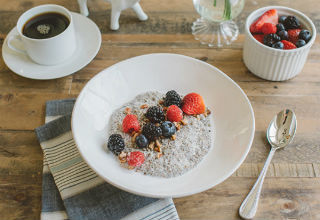 This is a guest post by Kelly LeVeque. Kelly is a certified holistic nutritionist, wellness expert and celebrity health coach based in Los Angeles, California. Be Well grew out of Kelly’s lifelong passion for health, the science of nutrition and overall wellness. Guided by a practical and always optimistic approach, Kelly helps clients improve their health, achieve their goals and develop sustainable habits to live a healthy and balanced life.
This is a guest post by Kelly LeVeque. Kelly is a certified holistic nutritionist, wellness expert and celebrity health coach based in Los Angeles, California. Be Well grew out of Kelly’s lifelong passion for health, the science of nutrition and overall wellness. Guided by a practical and always optimistic approach, Kelly helps clients improve their health, achieve their goals and develop sustainable habits to live a healthy and balanced life.
Good Morning! I’m Kelly LeVeque, nutritionist at Be Well by Kelly. You might have heard of my #bewellsmoothie—it’s a formula created to help my clients make the perfect meal replacement shake. The #bewellsmoothie limits fructose and ensures that there is enough protein, fat and fiber to balance blood sugar and help you calmly make it from breakfast to lunch.
No matter your lifestyle, at Be Well we suggest a blood sugar stabilizing and anti-inflammatory approach. We want our clients feeling full and satisfied so they can enjoy life without obsessing about food or grazing all day. Feeling energized will set you up to exceed goals—but excess insulin and fructose don’t help.
Fructose turns to fat faster than any other form of carbohydrate. When metabolized in the liver, fructose converts to glycerol (a sugar alcohol), which helps turn free fatty acids into fat. And, since fructose is 100 percent metabolized in the liver, it undergoes a chemical reaction that can result in liver inflammation. (For reference, only 80 percent of alcohol and 20 percent of glucose are metabolized in the liver, which shows how, in comparison, fructose can carry an extra health damaging kick!)
Research confirms that when we start our day with protein and fat we feel more relaxed around food and eat less overall. The right amount of fat and protein will get you from one meal to the next. Remember, breaks are good. A 4-5 hour window between meals will increase human growth hormone and testosterone levels, which helps you shed weight, maintain lean muscle mass, and increase insulin sensitivity. The result? You’ll experience a natural energy surge without a sugar crash.
So definitely consider giving your body a break with the #bewellsmoothie or my favorite weekend breakfast. This paleo chia pudding, which reminds me of growing up with Cream of Wheat and oatmeal, serves up protein, fat and fiber to keep you full.
Enjoy!
Ingredients:
1 tablespoon ghee or coconut oil
2 cup coconut or almond milk
3 tablespoons chia seeds
3 tablespoons ground flax seed
Optional Toppings:
4 tablespoons chopped pecans
2 tablespoons hemp hearts
¼ cup mixed fresh berries
Choose Sweetener:
1 serving Vanilla Coconut Primal Fuel (preferred)
3 Stevia drops
1 tablespoon coconut palm sugar
In a medium nonstick fry pan on medium heat, add 1 tablespoon of ghee, 1 cup of coconut milk, chia seed and flax.
With a silicon spatula or wooden spoon, continuously stir all ingredients until pudding is thick about, 3 minutes.
Pour warm pudding into a bowl, option to stir in sweetener of choice.
Top with nuts, hemp seeds coconut milk and berries. Serve warm.
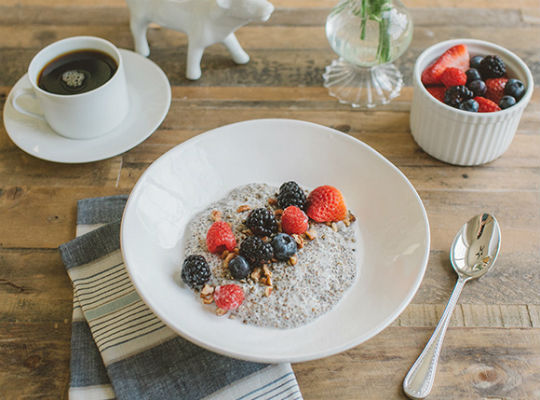




July 24, 2015
My Top 11 Benefits of Going Primal
It’s Friday, everyone! And that means another Primal Blueprint Real Life Story from a Mark’s Daily Apple reader. If you have your own success story and would like to share it with me and the Mark’s Daily Apple community please contact me here. I’ll continue to publish these each Friday as long as they keep coming in. Thank you for reading!
 I have, in the name of health gain and weight loss, experimented with vegetarianism, veganism, low fat dieting, a sugar-wheat-and-dairy-free diet (still low-fat or I’d have probably stuck with that one!), calorie counting and juice fasting over the past thirty years. Many of you reading will recognise the pattern of interspersing these oft-repeated and generally short lived regimes with periods of overeating either junk or a “healthy balanced diet.” It’s a frustrating, demoralising and damaging way to live.
I have, in the name of health gain and weight loss, experimented with vegetarianism, veganism, low fat dieting, a sugar-wheat-and-dairy-free diet (still low-fat or I’d have probably stuck with that one!), calorie counting and juice fasting over the past thirty years. Many of you reading will recognise the pattern of interspersing these oft-repeated and generally short lived regimes with periods of overeating either junk or a “healthy balanced diet.” It’s a frustrating, demoralising and damaging way to live.
During this time I have seen my weight yo-yo anywhere between 140 and 224 pounds. And along the way I’ve suffered crippling depression, anxiety, acne, frequent bouts of tonsillitis, chronic constipation, binge-eating, inexplicable periods of exhaustion, insomnia and brain fog.
I’ve always known that many of my issues were diet related, so I read everything on nutrition I could get my hands on. I even qualified as a nutritional therapist! But, despite seeing astonishing results with private clients I couldn’t seem to sort myself out. I felt rubbish. My confidence was shot.
But in May 2014, aged 41 and after suffering my worst and longest depressive episode yet, I read Sarah Wilson’s “I Quit Sugar.” And having gained some confidence over the next few weeks with a zero fructose intake, I looked into her suggested resources, which included Mark’s Daily Apple. Inspired by the success stories and encouraged by Mark’s obvious expertise, I got each of the fabulous Primal Blueprint books. It was like I’d come home! Finally something that instinctively, intellectually and academically made sense! I also devoured everything else I could get my hands on (pun intended) in the paleo/keto/bulletproof/bio-hacking world of books, blogs and podcasts. Even when I didn’t follow advice, it kept me inspired to just keep reading and immerse myself in this world.
I’ve not taken anything to extremes. Low energy and a household to run have meant that I’ve taken a two-steps-forward-one-step-back approach over the last year. But my diet is now based on eggs, meat, fish, veg, butter, cream, yoghurt, coconut oil, nuts and seeds and I feel better than I have for years. Here are the top ten benefits I have noticed in my own health and well being in the past 12 months…
Benefit #1
I no longer suffer with anxiety, or it’s tricky cousin, social anxiety. I can now deal with problems, incidents and events both at work and socially and I am now able to work through them without complete melt down, tears, belly ache, racing pulse or insomnia.
I’ve even been out with friends, which had not been possible for months before adopting a Primal lifestyle, and not agonised over each detail, felt responsible for other people’s moods or been paranoid that nobody wanted me there in the first place.
Benefit #2
No depression. No moping. No crippling lack of self-worth. No wishing the world would swallow me up. In 2013 I was unable to enjoy my summer holidays. My mood refused to elevate no matter what I did. Camping in the middle of nowhere, beautiful walks, parties with friends, even reading, playing the piano and family mealtimes – you name it, I was struggling not to cry at the sheer frustration of being able to enjoy it.
In contrast, the summer of 2014 was my best in memory, the highlight of which was having complete hysterics when I face planted off a paddle board in Cornwall rather than making the graceful dive I’d planned to execute. I howled with laughter until the tears streamed down my face. I’ve felt real joy on a number of occasions over the past year. I can’t stress how big a deal this is. Even with the day-to-day stuff like walking in the forest with my husband or curling up with my daughters – I’m finally able to live in the moment and fully enjoy these times.
Benefit #3
No binging. No cramming down a huge bar of chocolate / packet of biscuits / hastily made cake and then eating a meal an hour or so later. No eating until I physically throw up. No mindlessly working my way through a loaf of bread in an afternoon and then fighting to stay awake when my family arrive home. I occasionally lose control over crisps (potato chips?) but we are talking a couple of small packets, not an entire family bag of kettle chips.
I do still eat a lot, but I am not afraid of hunger any more. I’ve tried intermittent fasting but I’m not sure I manage very well on it. Having said that, my blood sugar is pretty stable now and, if necessary, I can skip the occasional meal without trauma!
Benefit #4
I get to sleep at night! Having suffered nightmares and insomnia since childhood I now sleep soundly. No more pacing the house in the early hours. No more tossing and turning. No more night sweats, hallucinations or midnight carb cravings. It’s like general anaesthetic! I turn the light out and I wake up 8.5 hours later.
Benefits #5, 6 & 7
My nails have stopped peeling, breaking and flaking and have become strong, shiny and flexible.
My previously thin and brittle hair is thickening up and becoming soft.
My acne has finally, after nearly 30 years, nearly cleared up and my developing wrinkles have been replaced with softer, plumper skin. (You can see from the photos below that I’ve lost that puffiness round my face too.)
Benefit #8
My body temperature is better regulated. I only realised this when I was swimming in the sea (UK summer water temperature maxes out at around 15 degrees Celsius) with only a bikini and light rash vest. I haven’t been able to do that since I was a kid! I’m getting better at handling heat too, which used to make me feel very uncomfortable. I’ll be putting handling these extremes to the test in November when I plan to take part in a Wolf Run, which includes swimming across a lake!
Also, despite having spent years trying to find a deodorant that worked on me, I don’t even need one any more. I’ll use a quick swipe of coconut oil if I’m working or running, but that’s it.
Benefit #9
A clear head. I have no idea how I made it through school let alone university; the combination of constant brain fog, undiagnosed dyslexia and social anxiety made my educational experiences somewhat sub-par. My reports were devastating. Teachers were frustrated with what they perceived as sheer laziness but the reality was that I was struggling to focus on what they were saying and to read while the words danced all over the page. I no longer suffer with brain fog unless I have eaten wheat, (which I still do occasionally and consciously!) and my focus is significantly better. I can also remember short sequences of numbers, letters or instructions which was previously impossible.
Benefit #10
I’ve only lost around 14 pounds, but look slimmer than I did previously at eight pounds less again; I guess I’ve made good muscle gain too. And I’ve been eating a lot! I take my coffee with thick (heavy) cream. I use a lot of butter. I eat homemade ice-cream. I devour pork crackling and streaky bacon. I certainly eat until I’m full at each mealtime!
After a great deal of experimentation I have discovered that I function best on a high fat breakfast, a small fat and protein based lunch and a large evening meal of meat, veggies and rice or sweet potatoes. No more heartburn or night sweats for me.
Running used to be a strain on my knees and ankles but there’s no discomfort now. I’m also getting to grips with a pull-up bar and a kettle bell (not simultaneously!). I plan to take my abysmally low fitness levels in hand this year, confident that I’ll soon be in better shape in my forties than I was in my teens.
Benefit #11
Now that I don’t need to cram food in – to give me energy, to make me sleepy, to comfort, to fill up, to alleviate or block out whatever emotions I cannot otherwise deal with, I am really enjoying my meals again. I do not fear hunger or get anxious before mealtimes. And so I get to savour and appreciate whatever I’ve served up. Bonus! My family is also enjoying the new variety of food that I’m dishing up and have noticed how much better their energy is compared with many of their friends and colleagues.

In essence, life is good and I feel like it’s only really just getting started. I still get upset, angry, nervous and tired – but these states of being are generally proportional to what’s actually going on. Leaving me to get on and enjoy the rest of life without self-sabotage. If this is what getting older is like then bring it on!
Huge thanks for all the time and effort you put into your books and website Mark. Truly inspirational!
Florence




July 23, 2015
Limited-Time Offer: Enter to Win My Favorite Things
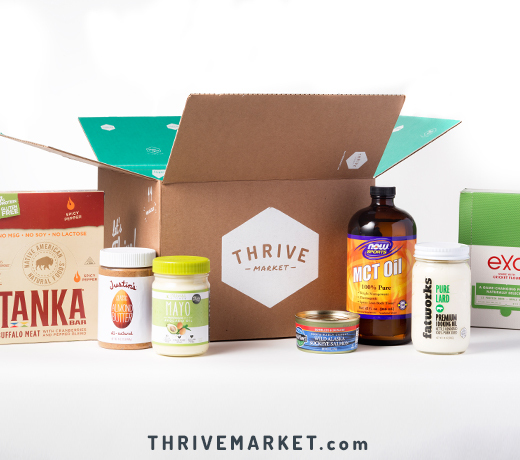 I’ve got another really cool free contest for you: Enter to win a $100+ valued gift box of my favorite Thrive Market products.
I’ve got another really cool free contest for you: Enter to win a $100+ valued gift box of my favorite Thrive Market products.
Here are a few more logistics: No purchase required…three lucky winners will be randomly selected…and you’ve gotta seize the day, because the offer expires on July 29.
Update: Good news! Thrive Market has made some technical updates. Now existing Thrive Market members can enter, too, so members and non-members alike eligible to win.
I jumped at the opportunity to participate in this contest because it gives me a way to solve a very common dilemma. A question I hear all the time from Mark’s Daily Apple readers, and my family and friends who are interested in living primally, is “how do I start?” And then, “where do I go from here” and “how do I keep it going?”
Though most of your diet is comprised of fresh fruits and vegetables, grass-fed meats, and free-range poultry, you always need a few paleo-friendly condiments, simple snacks, and nonperishable goods. So to help simplify the primal life, I put together a box of all of my favorite paleo staples. These are the foodstuffs I always have on hand and eat daily. With a box of these goodies in your kitchen, you’ll have a really solid foundation on which to build your new healthy routine or maintain your dedication to primal eating.
Let me show you what I mean. Check out this short video to see a sampling of what Thrive Market delivers to my door each week.

And here some of my other favorites. These primal/paleo grocery items are yours for free if you’re one of the lucky winners:
1. Primal Kitchen Avocado Oil Mayo: $7.45
If you haven’t tried my paleo-friendly avocado oil mayo, you’re missing out. Full of healthy fats (no canola or soybean oil in sight!), this stuff is the best in a curried chicken salad or as the base for homemade dipping sauces.
2. Exo Apple Cinnamon Protein Bars: $27.95
These protein bars are made from cricket flour, the most sustainable source of protein on the planet. Plus, they have a great apple cinnamon flavor and don’t use any refined sugars.
3. Fatworks Food Pure Lard: $14.45
Lard has a very subtle flavor that enhances just about anything you cook with it. And, since it won’t burn like butter or degrade like olive oil, lard doesn’t come with the risk of free radicals.
4. Tanka Natural Buffalo and Cranberry Bar: $26.95
These spicy pepper buffalo bars really can’t be beat for flavor or nutrition.
5. Justin’s Classic Almond Butter: $11.25
Almond butter goes great in smoothies, breakfasts, paleo desserts, you name it. This particular brand doesn’t use any sweeteners or artificial junk—just almonds and sustainably sourced palm oil.
6. MCT Oil: $17.45
MCT stands for medium chain triglycerides, a type of fat the body uses for almost instant energy. I like to boost my morning coffee or smoothies with a glug of this oil.
7. Wild Planet Non-GMO Wild Pacific Sockeye Salmon: $6.45
I love salmon, but I generally try to avoid the farmed stuff. This wild-caught sockeye salmon is top of the line, both in flavor and eco-consciousness.
The retail value of this box? Just $111.95. And that includes two whole boxes of protein bars and six other paleo staples.
There’s something thrilling about opening your front door and seeing a box full of healthy and delicious fare from Thrive. So if you haven’t tried Thrive Market yet, then you’ve got nothing to lose and over $100 worth of food staples to gain. Enter here for your chance to win!
P.S. I should mention that Thrive Market currently ships to all residential and commercial addresses in the Contiguous U.S. They do not currently ship to P.O. boxes, Alaska, Hawaii, Puerto Rico, or Canada, but hope to do so in the near future.
P.P.S. Contrary to what I originally stated in this blog post, even existing members of Thrive Market can participate in this contest. Everyone is eligible.
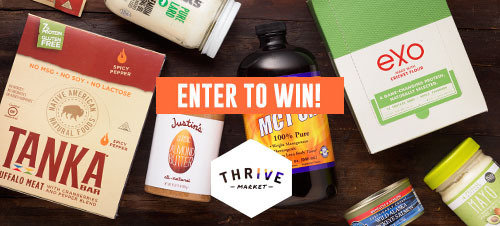
Prefer listening to reading? Get an audio recording of this blog post, and subscribe to the Primal Blueprint Podcast on iTunes for instant access to all past, present and future episodes here.



July 22, 2015
The Primal Laws: 8 Honorable Mentions
 Way back in 2008, I revealed the foundation underpinning the Primal Blueprint: the 10 Primal Laws. These behaviors and environmental influences comprised the daily lives of our ancestors for hundreds of thousands of years and continue to shape our collective genomes today. Even if you haven’t read the book, definitive guide, or seen the laws before, they should look pretty familiar. Most everything I write about on this blog and in my books uses them as touchstone. Much changes, but everything stays the same:
Way back in 2008, I revealed the foundation underpinning the Primal Blueprint: the 10 Primal Laws. These behaviors and environmental influences comprised the daily lives of our ancestors for hundreds of thousands of years and continue to shape our collective genomes today. Even if you haven’t read the book, definitive guide, or seen the laws before, they should look pretty familiar. Most everything I write about on this blog and in my books uses them as touchstone. Much changes, but everything stays the same:
Eat lots of animals, insects, and plants.
Move around a lot at a slow pace.
Lift heavy things.
Run really fast once in awhile.
Get lots of sleep.
Play.
Get some sunlight every day.
Avoid trauma.
Avoid poisonous things.
Use your mind.
If you follow those 10 foundational laws, you’ll be setting yourself up for a healthy, vibrant life. But what else is there? What were the honorable mentions that didn’t quite make the cut? In no particular order, here are several additional lifestyle behaviors that are central to my life and were a big part of our ancestors':
1. Hang out with dogs.
Sorry, cat people. I love cats, and they can certainly provide companionship and free vermin extermination, but we simply don’t share as extensive an evolutionary history with cats as we do with dogs. That’s probably why dogs can judge a person’s emotional state from their facial expression, notice when you’re smiling, and perceive whether we’re happy or disgusted. When you gaze into your dog’s eyes, you’re both getting hit with oxytocin. That’s how deep the bond runs. I don’t know about you, but I’d be careful about severing that bond, or never having it at all. It seems to be intrinsic and essential.
Plus, on the purely utilitarian tip, dog ownership is linked to increased physical activity (dog’s gotta walk!).
Owning a dog isn’t for everyone. You need the time and compulsion to exercise them, feed them, and love them. But the cool thing about a dog is that they have a nearly limitless capacity to love. If your best friend has a dog, chances are that dog loves and respects you. So if you’re not a dog owner yourself, find a way to spend time with them. Volunteer at a shelter. Be a foster parent to dogs in need of permanent homes. Or just find a cool dog park and go hang out every once in awhile.
2. Gaze at the stars whenever you can.
Go camping on a clear night away from urban light pollution, look upward, and be amazed. Now realize that for hundreds of thousands of years of human prehistory, that’s what we saw every time we looked up at the sky at night. Entire galaxies. Impossible numbers of stars. Constellations so distinct that you finally understand what those ancient Greeks were talking about. That’s the backdrop of ancestral chill-out time. That, the company we kept, and the fire flickering before us were the nighttime entertainment.
I don’t pretend to star gaze as often as I’d like. Malibu is remoter than you might think, but our proximity to one of the world’s most sprawling metropolises reduces visibility. For most, stargazing means something entirely different in LA County. But when I get to do it, when I’m camping with the family or on a snowboarding trip or anywhere at all that allows unfettered visual access to the stars, I take advantage. And I come away feeling humbled. How can a person maintain a large unwieldy ego in the presence of such immensity and eternity?
3. Go frequently to a green place.
I’ve extolled the extensive virtues of green spaces, particularly in the context of city living. It’s become quite clear than spending time in nature isn’t optional, it’s essential. Simply being, let alone living, near green space has a number of physiological and psychological benefits:
It reduces stress.
It improves immune function.
It lowers blood sugar.
Check the post linked above for 13 more proven benefits. Overall, nature is simply relaxing, beautiful, and a great place to exercise. Trails just ask to be run upon, trees silently implore you to climb them, and beaches are always requesting that people sprint all over them. Plus, it’s where we come from. Nature is the human constant. It’s our “normal.” Cities, towering skyscrapers, walls, fences, concrete covering everything within five miles? That’s the aberration. Going for a hike in the forest is going home.
Side note: By “green space,” I mean anything where nature pervades: parks, forests, marshes, swamps, beaches, deserts, gardens. It needn’t actually be green.
4. Consort with natural water.
As I’ve written before, humans have an interesting connection to water. Sure, we need to drink it, and thirst’ll kill us before hunger. Sure, lots of delicious goodies reside in water, and the ever-important long chain omega-3 fats that may have facilitated rapid brain expansion are found almost exclusively in water-dwelling creatures like fish and shellfish. But it goes way deeper than that. Emerging evidence confirms our deep connection to the deep blue, finding that “blue space” improves well-being, reduces anxiety and depression, and can even improve resistance to cancer and other degenerative diseases (PDF).
So find a river, lake, or pond (preferably one not frequented by incontinent waterfowl) and hop in. Go to the beach and take a dip. You don’t even have get wet. Kayaking, standup paddling, surfing (just don’t fall!), or any other type of self-propelled water vehicle are valid ways to visit the water. Pools are great (especially if they’re salt water; I use mine frequently) and certainly convenient, but there’s something about swimming in clean, natural water that can’t be beat.
I’ll also tack on the importance of consuming mineral water. It’s likely that early humans got a significant amount of essential minerals from the water they drank. My favorite is Gerolsteiner, out of Germany. Tons of calcium and magnesium and a perfect amount of carbonation. Just check the label for mineral content; some “mineral waters” have shockingly low levels.
5. Direct your gaze toward distant objects and sights.
We spend so much of our time these days huddled over a desk or smartphone, staring into a screen 8-12 inches from our faces, for hours upon hours on end. It’s objectively terrible for our posture (unless we take pains to constantly remind ourselves to sit and stand correctly) and I’d argue that along with lack of sun exposure it contributes to the degeneration of our eyesight.
Plus, as with the star gazing, looking far off into the distance realigns what actually matters. Every time I spend an hour watching the sun dip down below the waves, often with Carrie and/or Buddha (my lab) and Shanti (my goldendoodle), I am refreshed. It’s not scientific, and there are certainly confounding variables (the beach, the wife, the dogs), but man if every little thing I was worrying so much about didn’t seem smaller and less important after watching a ball of galactic fire turn the sky crimson from 93 million miles away.
6. Consume stories.
It doesn’t really matter what form you consume: movies, television, books, comics, podcasts, public radio. What’s important — and, I think, essential to being human — is the consumption of stories, tales, yarns, legends, myths, and literature. There’s a reason why stories resonate with us, why the best way to change minds or hearts is to tell them a story. That’s how we passed the time for thousands of years before TV, radio, or even the written word. That’s why politicians tell stories in speeches (because sticking to facts and statistics will only reveal their ineptitude and corruption). It’s why anecdotes, even if they come from anonymous commenters on Internet message boards, are often more convincing than objective scientific studies. It’s why we’re liable to binge watch TV shows as our life crumbles around us.
Stories are how humans relay experiences, convey lessons, entertain friends, make important points, and explain otherwise confusing concepts. If you can’t tell good ones — it takes a gift, in my experience — listening (or reading/watching/etc) is just as valid. Not everyone is a writer or crier or storyteller. And that’s okay. That’s human.
7. Sit around a fire.
This’ll be one of those dreaded “just-so stories” upon which the skeptics like to claim the entirety of ancestral health rests. So what?
As long as humans have controlled fire, they’ve sat around it at night. For warmth and illumination or to cook. Or for entertainment and to ward off insects and animals. Many a long comfortable silence was spent staring into the dancing flames. And sure enough, modern research confirms that campfires induce the relaxation response, biasing us toward the parasympathetic nervous system, lowering blood pressure, and making us more social with our companions.
Side note: Fireplaces should work, too.
8. Make yourself useful.
This means cultivating a skill, a quality, or a craft that others find useful. It could be cooking (people need to eat), or writing (people need to read and learn), or massage (people have stiff/sore tissues), or skateboarding (people need to be amazed), or fixing cars (people’s cars need to run), or carpentry (people need roofs over their heads). It can be literally anything fitting the criteria. Learn to do something that others would or do find useful.
Are these essential Primal laws? For me, they are. For you, perhaps not. But I’m confident adhering to most of these Laws would benefit your lives, too. Campfires? Skill development? Walks in the forest? Refreshing swims in the ocean? A fluffy friendly dog? What’s not to love?
I’m incredibly curious to hear your feedback. Do any of these honorable mentions deserve full Primal Law status? Which do not?
That’s it for today, folks. Thanks for reading!




July 21, 2015
From “The Games” to “The Cert”: The Story Behind the Grundler Brothers
 Today marks the launch of an annual competition I’m sure you’re all familiar with: The CrossFit Games. For those of you out there who love CrossFit—for the challenge it offers, the physical results it produces, and the community it provides—you’ll get to tune in for a daily dose of inspiration. And for those of you who don’t practice CrossFit, the takeaway from today’s story is the same: taking the plunge, deepening your knowledge, and having someone supportive to cheer you on and test your limits, can lead to extraordinary accomplishments. Life is about picking new challenges and conquering them with your clan, your tribe, your family (whether the ones you’re born with or the ones you choose). I know we have our own primal tribe here at Mark’s Daily Apple, so I thought it’d be worth sharing a story about living awesome with the support of a community that wants to see you succeed.
Today marks the launch of an annual competition I’m sure you’re all familiar with: The CrossFit Games. For those of you out there who love CrossFit—for the challenge it offers, the physical results it produces, and the community it provides—you’ll get to tune in for a daily dose of inspiration. And for those of you who don’t practice CrossFit, the takeaway from today’s story is the same: taking the plunge, deepening your knowledge, and having someone supportive to cheer you on and test your limits, can lead to extraordinary accomplishments. Life is about picking new challenges and conquering them with your clan, your tribe, your family (whether the ones you’re born with or the ones you choose). I know we have our own primal tribe here at Mark’s Daily Apple, so I thought it’d be worth sharing a story about living awesome with the support of a community that wants to see you succeed.
If you’re up to speed on all the latest CrossFit Games news, then you’ve probably heard about the Grundler brothers. If you haven’t, you should. Bill and James Grundler have made a splash this year—and for good reason. The power duo are the first brothers to ever compete in the Games together, and they’ve shown that there’s a lot to be gained from having someone close, and knowledgeable, to help you achieve your goals. The two started off competing against each other in high school wrestling (proto-WFF stars by their own tongue-in-cheek accounts). But as the two grew up, they went their separate professional paths—Bill into a career as a high school athletics coach, firefighter and trainer, and James into the music biz, where he toured as the lead vocalist in a popular indie rock band. So how did CrossFit and primal living come into the mix?
The love of competitive fitness stayed strong in Bill—never leaving him from his early days as a kid who competed in swimming and wrestling. So he found a career path that piggybacked off his passion. As a captain of the Pismo Beach Fire Department, Bill had to stay in shape as a job requirement. Firefighters need to be healthy, fit and strong. It’s an occupational necessity. Honestly, there’s not much more of a primal-adapted job that comes to mind. Unlike most modern desk jobs, lifting heavy things and strengthening your body through functional movements is pretty much an essential part of your day (try lifting the dead weight of a person or smashing down the door to a burning building—you’re not going to get that kind of power with chronic cardio or spin class). That’s why in 2008, years after he had been using CrossFit for his own personal gains, Bill implemented its techniques for his fellow firefighters—who all had similar success. Eventually, he took his practice to the next level and opened up his own CrossFit gym up in San Luis Obispo, California: CrossFit Inferno.
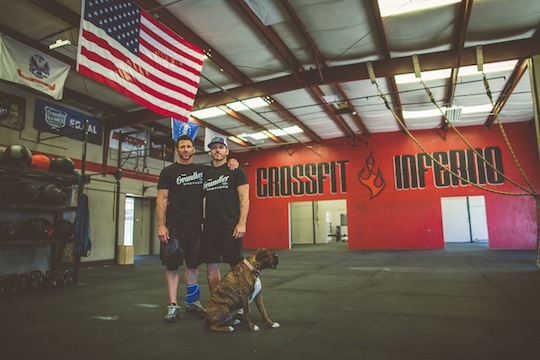
James, on the other hand, went into the music business—exercising his vocal cords (instead of his biceps or trapezius) while touring as lead vocalist with his band, Golden State. And by his own account, being fit just didn’t quite “fit” in with the artistic vibe that comes along with being a rock star—something many of us with a non-physically demanding job often use as an excuse not to exercise. While Bill was building muscle, James was building a music career. And that’s how things went, until James made an about-face (an “Aha!” moment that most of us can identify with) a little over a year ago. It was time to return to his athletic roots.
Following in his brother’s footsteps, James got into CrossFit. He trained hard and even started getting some recognition. But he asked his older brother if he thought he had the chops to compete in the Masters Division at the CrossFit Games. Bill, the encouraging older brother he is, said that if James dedicated himself for the next year, he could crush it. But now, with both brothers in the same sport, James reminisced about the good old days when the two would spar together. So James asked Bill if he would not only be his mentor, but also join him in competing in the Masters Division—something that Bill (a well-known CrossFitter) had always qualified for, but always refused to do, even at the behest of close friends. Bill was steadfast on competing as an Open Athlete against the top competitors in the field, not as a member of the Masters Division, which is restricted to an older age range. After Bill’s injury in 2014, Bill only expected to qualify for the Masters Division, which, for him, meant sitting the Games out altogether.
But seeing James’ enthusiasm moved Bill to make his own about-face—and he made a deal that if James’ qualified for the Masters Division, Bill would join him. The thrill of competing with his brother changed his seemingly unmovable perspective, and shined a whole new light on Bill’s motivation to join the Games. And so the brothers’ training began.
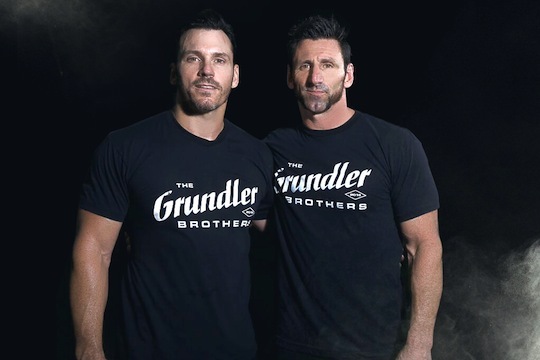
In pursuing optimal physical fitness, Bill had already taken up the paleo/primal lifestyle along with a rigorous CrossFit routine. He knew that eating a clean, primal-aligned diet gave his body the fuel it needed for his rigorous training without the crashes, insulin resistance, and unrelenting hunger that inevitably comes with following a Standard American Diet. But James needed some reintroduction to the fold—and Bill was there to give him that reintroduction.
James had his work cut out for him, but after some rigorous dedication, sweat, and fun, each of the brothers received his letter of acceptance to compete in the Games. And both of them accepted the invitation to compete in the Masters Division together as brothers.
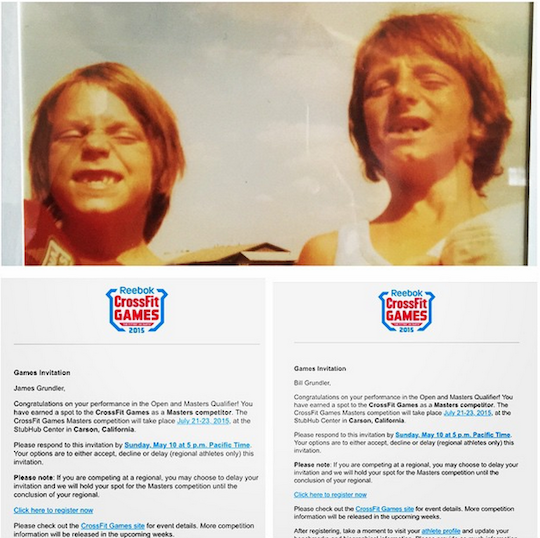
They had trained hard together. And now they were ready to compete hard together. What started as a form of play and an opportunity for bonding (like getting together with friends for a weekly match of Ultimate Frisbee) ended up creating some real success. That’s something I always try to keep in mind when tackling a new project: the importance and power of the primal instincts that carry us through each of our daily challenges. Things like community, competition in the service of a common goal, and play cannot be underestimated.
I share this story because one of our stellar worker bees over here at Mark’s Daily Apple happened to know the brothers. And the brothers knew about us. In fact, they also knew about something that piqued their interest: The Primal Blueprint Expert Certification. Bill, having already gained his level 4 certification in CrossFit (a level of certification very few trainers possess), wanted a challenge that rounded off his education in a way that married his expertise in functional fitness with the paleo/primal lifestyle that propelled him into the Games. And James, wanting a deep, comprehensive immersion into the hows and whys of a primal lifestyle, was just as curious as Bill. So we inducted the two as Cert students. It’s an opportunity they took on full force in a way that proved what I always say: an investment in yourself (along with a growth mindset) pays the highest dividends. The Cert gave the brothers a way to bond over their common goal—and that extra level of expertise to help them defy odds and expectations. So, after completing the program, each brother—now a Primal Blueprint Certified Expert—has provided his new wealth of resources to friends, family and clients.
So check out the video below, learn more about their story, and join us here at Mark’s Daily Apple in celebrating their journey, which mirrors things we create here every day: a supportive community, a series of goals, a set of challenges designed to help meet those goals, a sense of competition in the spirit of play, and a love for deeper knowledge.
Grok on, brothers, and good luck at the CrossFit Games!




July 20, 2015
Dear Mark: Metformin for Life Extension, Too Many MEDs, MED for Lifting Addict, and Horseback Riding
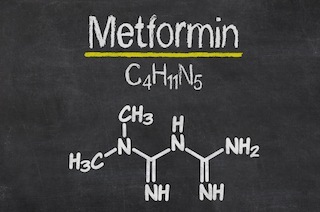 For today’s edition of Dear Mark, I’m answering four questions. First, does the diabetes drug metformin have life-extending potential for non-diabetics? Then, the final three questions come from the comment board of last week’s Minimum Effective Dose post. First, is it possible to try to do too many minimum effective dose workouts in a week. Yes, absolutely. I explain why a reader who seems to want to incorporate every single routine listed in last week’s post probably shouldn’t try. Next, what if someone truly loves training? Should he or she still try to figure out the minimum effective dose for his workouts? And finally, is horseback riding an effective stand-in for walking?
For today’s edition of Dear Mark, I’m answering four questions. First, does the diabetes drug metformin have life-extending potential for non-diabetics? Then, the final three questions come from the comment board of last week’s Minimum Effective Dose post. First, is it possible to try to do too many minimum effective dose workouts in a week. Yes, absolutely. I explain why a reader who seems to want to incorporate every single routine listed in last week’s post probably shouldn’t try. Next, what if someone truly loves training? Should he or she still try to figure out the minimum effective dose for his workouts? And finally, is horseback riding an effective stand-in for walking?
Let’s go:
I wondered if you had seen the New Scientist article on the anti-ageing metformin study being undertaken? Increases life expectancy, lowers heart disease and cancer risk …oh, and it’s a diabetes drug, so it works on lowering blood glucose! Which I imagine a primal blueprint would do too…
Dan
I haven’t seen the New Scientist article (it’s behind a paywall), but I am aware of the generally positive research being done on metformin. It’s becoming increasingly clear that not only diabetes patients may be able to benefit from metformin. Robb Wolf was beating this drum back in 2012.
There are many indications of metformin’s life-extending potential:
Metformin activates AMPK, the same autophagy pathway activated by exercise, fasting, polyphenol consumption, and reduced calorie intake.
Metformin also seems to protect against many of the conditions that kill people, like cancer. It lowers hyperinsulinemia and may protect against insulin-related cancers (breast, colon, etc). Early treatment during adolesence, for example, protects rats against later tumor growth.
Type 2 diabetics (a population with lower overall mortality) who take metformin live longer than age-matched controls who don’t have diabetes. That’s huge.
Metformin appears to work on lifespan via hormesis. Diabetics who need it just to keep their blood sugar in check are taking (and should take) it regularly, but if you’re just an experimenter interested in potential life extension, treating it like a hormetic input like fasting or intense exercise is probably a better, safer approach.
It appears that metformin may also act via modulation of the gut bacteria (surprise, surprise). It increases mucus production in the gut, which the resident bacteria are able to feed upon and increase in strength and number. It’s been shown to boost Akkermensia count, the strain commonly linked to leanness and anti-diabetic effects. Some studies have even shown that Akkermensia can improve gut barrier function in obese subjects, so metformin may be especially helpful for this population. Additional effects include reduced carb absorption by the host (that’s you), leaving more to be consumed by gut bacteria (a la resistant starch).
Berberine might be a “natural alternative” to metformin. Like metformin, berberine can activate AMPK, lower blood sugar and improve blood sugar control, and enhance short chain fatty acid production by gut bacteria. Being a whole plant extract, berberine isn’t identical to metformin, so I wouldn’t suggest diabetics switch without consulting their doctor, but it is a promising alternative that doesn’t require a prescription.
Overall, metformin looks promising. I’m not sure it’s an essential part of a longevity-promoting regimen if you’re already fasting, training, and eating colorful polyphenol-rich fruits, vegetables, spices, and dark chocolate, but I’m certainly open to the idea and await further research.
Hi, Mark,
Thank you. Would you be so kind to say a few words? What regime could work, as you stated doing all of them would make the workout protocol too strenuous and ineffective?
Is my idea below on the protocol OK?
week 1
MON 5x 4-minutes intervals
TUE 30-sec bike sprints
WED Tabata
THU 4-sec all-out sprints
FRI Tabata
SAT 30-sec bike sprints
SUN rest day
week 2
MON 7-minute workout
TUE 4-sec all-out sprints
WED Tabata
THU 30-sec bike sprints
FRI Tabata
SAT 4-sec all-out sprints
SUN rest day
Walking daily.
Can I add sprint intervals to Tabata day instead of doing them on a separate day?
Wish you all happy workouts,
Borut
I’d argue that the sprints, the Tabata intervals, and the 4-minute intervals are mutually exclusive. Your suggested weekly regimens are pretty rough and, for most people —including elite athletes — impossible to keep up with.
You must realize that in most of those studies, researchers precluded subjects from doing extra training. Since they were only interested in testing the effects of specific workout volumes, allowing them to engage in other types of workouts would only weaken and confound the results. The soccer player study with the 4-minute intervals was the only one to my knowledge that allowed other training on the side.
Let’s take your first week. Nearly all-out 87-97% max effort intervals lasting four minutes are not something you just tack on to the end of a workout. They are seriously hard. I know, because I used to run similar intervals back in my heavy training days. They’re designed almost entirely for people who aren’t doing much of anything else. And these were semi-pro soccer players doing them once every two weeks with no other formal training prescribed to them. They had two weeks to recover in between bouts. Trying to squeeze in six sprint sessions a week on consecutive days is just asking for lower results.
In fact, you might destroy your fitness and recovery by overloading the system.
Here’s what I might do to incorporate some of the protocols mentioned last week, assuming I’m trying to do the absolute minimum.
MON: 7-minute workout
TUE: 30-second bike sprints
WED: Rest
THU: 7-minute workout
FRI: 4-second all out sprints
SAT: Play (hike, pick-up game, bike, surf, swim, or even go see a movie or have a dinner party; it doesn’t always have to be physical)
SUN: Play
Walking daily? Always a good idea.
I don’t much care about my health but I enjoy lifting weights, and I like to look good, so I do as much weight lifting as I can given my age. I understand that some people do not enjoy exercising but if you’re the kind of person who does enjoy it, it’s hard to wrap your mind around the concept of minimizing time spent exercising. To me it’s like suggesting that I minimize the time I spend having sex.
I hear you, but I think we’re actually in agreement. As I was unable to find any solid evidence that very low volume strength training elicits favorable reactions to as great a degree as low volume sprints, I suspect shorter and sweeter works better for conditioning and general fitness. If you want to get big and really strong, you’ll probably need more time than a few minutes a week (although Doug McGuff’s Body By Science program might beg to differ).
Ultimately, the post was all about efficiency of exercise. Being efficient lets you maximize the effectiveness of your time in the gym. Efficiency means having more time left over to do what you truly love. If that’s lifting heavy, then go lift heavy. If that’s sex, go have sex. If it’s playing Ultimate Frisbee and standup paddling (which it is for me), go do those things with your extra time.
No matter how much you love to lift weights, you still want your time under the bar to be productive, right? Efficiency matters for you too, then.
Wondering how horseback riding stands in for walking? I ride about 45 minutes most days at moderate intensity (jumping and dressage, not noodling down the trail) and hope it’s a good stand-in, because I have trouble finding time for long walks as well.
At least in healthy kids, simulated horseback riding elicits lower cardiorespiratory responses (heart rate, energy expenditure, etc) than even slow walking on a treadmill. That was simulated riding, of course, which is probably very different from real riding. Even so, it’s likely not as metabolically demanding as walking overground, but that doesn’t make it useless. Contrary to what many people might believe, horseback riding is absolutely a form of exercise.
Horseback riding improves functional trunk stability and proprioception, effectively making the rider better at navigating the environment and staying upright and stable.
It’s not just good for on the horse balance; it improves standing one-leg balance and dynamic balance ability as well. It even works in older adults and patients recovering from strokes.
Just this year, a study found that horseback riding can have positive effects on gait and body weight in obese women.
Now, can it replace walking? No, I doubt it. Walking is the foundation of health. But nor can walking replace horseback riding. Do both when and however you can. And if you can’t walk as much as you (or I) would like, know that it’s doing “something.”
That’s it for this week, folks. Thanks for reading and be sure to help out with your own answers and comments down below!




July 19, 2015
Weekend Link Love – Edition 357
 Interested in the Primal Blueprint Expert Certification Program? It’s easier to invest in yourself and go deeper into Primal living than ever before with our Dollar Down Payment Plan. Just put down $1 today and $89 for the next 12 months and you gain instant access to the most comprehensive online ancestral health program in the world.
Interested in the Primal Blueprint Expert Certification Program? It’s easier to invest in yourself and go deeper into Primal living than ever before with our Dollar Down Payment Plan. Just put down $1 today and $89 for the next 12 months and you gain instant access to the most comprehensive online ancestral health program in the world.
Research of the Week
Feel like an afternoon snack? Berries will keep you fuller longer than an equally-caloric baked item.
Most packaged gluten-free foods are just as unhealthy as their gluten-replete counterparts.
Romantic-sexual kissing doesn’t appear to be a human universal.
“Stone age conditions” prolong sleep.
In indigenous Australians and Papua New Guineans, mingling with the Denisovans (the “other Neanderthal,” an ancestral human living primarily in Asia) introduced genes related to “spermatogenesis, fertilization, cold acclimation, circadian rhythm, development of brain, neural tube, face, and olfactory pit, immunity,” as well as “female pregnancy, development of face, lung, heart, skin, nervous system, and male gonad, visual and smell perception, response to heat, pain, hypoxia, and UV, lipid transport, metabolism, blood coagulation, wound healing, aging.”
New Primal Blueprint Podcasts

Episode 76: Diana Rodgers: Host Elle Russ hangs out with sustainable farming advocate Diana Rodgers. Learn how Diana got into ancestral health by way of gluten-free dieting, whether there’s still vacant land that can be grazed, why her farm is “community-supported,” and how anyone who cares at all about what they eat must also care how their food is grown and raised.
Each week, select Mark’s Daily Apple blog posts are prepared as Primal Blueprint Podcasts. Need to catch up on reading, but don’t have the time? Prefer to listen to articles while on the go? Check out the new blog post podcasts below, and subscribe to the Primal Blueprint Podcast here so you never miss an episode.
Instant Access to “The Cert” for Just $1
5 Ways to Get the Most Bang for Your Workout Buck
Take the 1000 Day Challenge!
Doctors of the Future: 3 Promising Trends in Medical Education
Also, be sure to check out and subscribe to the Primal Endurance Podcast.
Weekly sweepstakes: Write a review for The Primal Blueprint Podcast or The Primal Endurance Podcast on iTunes and submit this form for a chance to win a Primal prize package. One new winner is chosen every week!
Interesting Blog Posts
The Fat Emperor on insulin and missed opportunities.
Will taxing saturated fat actually prevent any deaths?
Paul Jaminet with an interesting post on antioxidants, exercise, and whether bigger muscles are always better (or stronger).
Could lower dietary fiber diversity lead to higher diversity in the gut biome?
Media, Schmedia
Apparently, sunbathing is far more dangerous than driving a car. Hmm.
The people who need very little sleep.
Long time gluten-free dieter Novak Djokovic just won Wimbledon.
Everything Else
Scott Jurek just hiked the Appalachian trail in 46 days, 8 hours, and 7 minutes, averaging 50 miles a day.
Portland’s police horses now wear minimalist footwear. Dang hipsters.
The FDA adds “heart attack” and “stroke” to NSAID warning labels.
Oregon State University scientists have cultivated a type of dulse seaweed that apparently tastes like bacon.
The evolution of prosthetic legs.
Doodling may help you think, even if you’re bad at art.
Why BMI doesn’t work for everyone.
Recipe Corner
If you can find black garlic, try making grilled sweet potatoes with it.
The perfect paleo pizza?
Time Capsule
One year ago (Jul 21 – Jul 27)
Yearning for the Wild – Do you feel the call?
The “Dangers” of Going Gluten-Free – How ever do we survive?
Comment of the Week
Charlie Parker became the most influential jazz musician of the 20th century in about 1000 days. I like it. Being a musician and all. Thanks for posting it
Todd
– Really cool to know. Thanks, Todd.




July 18, 2015
Primal Chicken Spaghetti
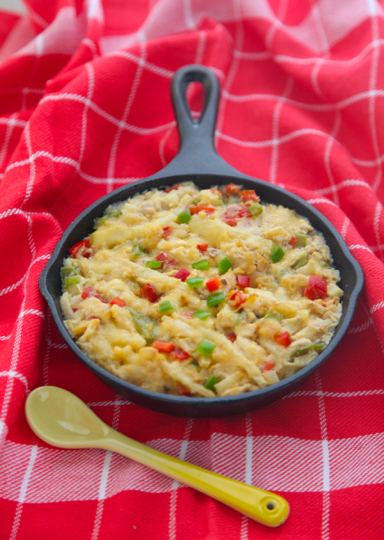
Chicken spaghetti is comfort food at its best and worst. It has that comforting casserole flavor that’s mild, but not bland, and a creamy, baked texture. But that’s where the goodness stops. Layers of spaghetti noodles, canned cream of mushroom soup and gooey cheese make chicken spaghetti a meal to be avoided at all costs.
But what if chicken spaghetti could be remade into a healthy casserole that tastes really similar the traditional recipe? In the case of chicken spaghetti, this means the casserole should be creamy but not taste like coconut milk, and have the texture of noodles without tasting like (spaghetti) squash. Both of these things can be achieved by using celery root.
Celery root has a neutral flavor and color. It can be turned into a creamy puree or cut into noodle-like matchsticks. In this recipe, it’s a perfect stand-in for cream of mushroom soup, the glue that binds chicken spaghetti together. It’s also a perfect stand-in for noodles.
Must cheese be forsaken entirely? It’s hard to imagine chicken spaghetti without it. If you don’t do dairy at all, then yeah, you can leave it out. But if you don’t mind a little bit of unpasteurized, aged cheddar, then this dish will taste better for it.
You might have to make this recipe to believe it – Primal chicken spaghetti really does taste like chicken spaghetti should (only better). It’s healthy and comforting. The best of both worlds.
Servings: 4
Time in the Kitchen: 1 hour
Ingredients:
3 cups cooked, shredded chicken (white and/or dark meat) (400 g)
2 celery roots (about 12 oz/340 g each)
1/4 cup chicken broth (60 ml)
3 tablespoons unsalted butter, divided (45 g)
1 small onion, finely chopped
1 green bell pepper, finely chopped
1 red bell pepper, finely chopped
1 cup grated unpasteurized, aged Cheddar (90 g)
¼ teaspoon cayenne (1.2 ml)
¼ teaspoon salt (1.2 ml)
Instructions:
Preheat the oven to 350 ºF/177 ºC.
Use a paring knife to trim the skin off each of the celery roots. Cut the roots into sheets 1/4-inch (6 mm) thick, trimming the sides to make squares or rectangles (keep the scraps). Then cut the sheets into noodles that are ¼” (6 mm) wide.
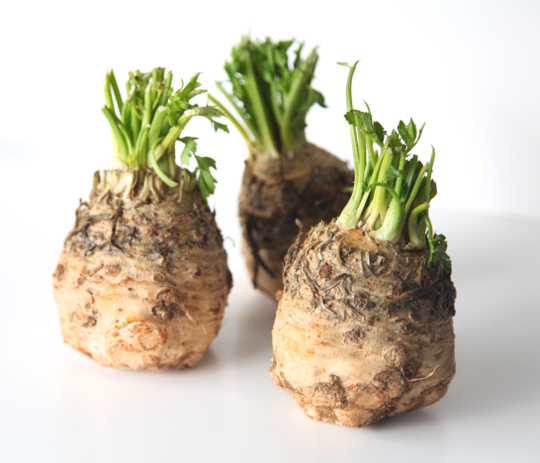
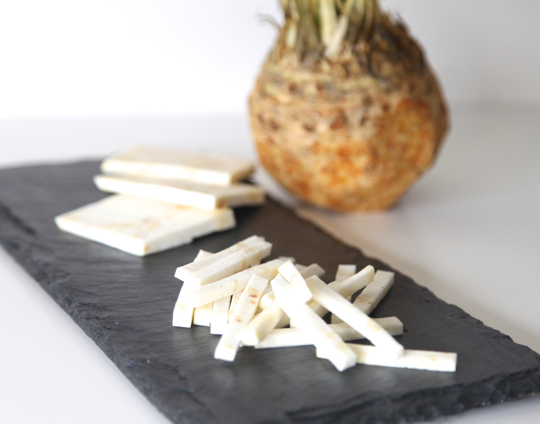
Toss the celery root noodles into a pot of boiling water and cook just until fork tender, but not mushy. This should take not much more than 5 minutes. Drain and set aside.
Gather up all the misshapen scraps of celery root that are leftover and cut them into evenly sized pieces, so they’ll cook evenly. Toss the pieces into a pot of boiling water. Cook until very soft, then drain. Put the cooked pieces in the food processor with the chicken broth and 2 tablespoons/30 g of the butter. Puree until very smooth. Add salt to taste. Set aside.
Melt the remaining tablespoon of the butter in a skillet over medium heat. Add the onion and saute until soft, about 5 minutes. Add the bell peppers and sauté a few minutes more.
In a large bowl, combine the cooked chicken, celery root noodles, onion and bell peppers, cheddar cheese, cayenne and salt. Gently stir in the celery root puree (hopefully you have close to 1 cup of puree). Add more salt as needed, so the dish has ample flavor.
Smooth the mixture out into an 8×8 square (2L/2 quart) baking dish. If you like, sprinkle another ½ cup/45 g grated cheese on top.
Bake uncovered for 30 minutes until warm and bubbly.
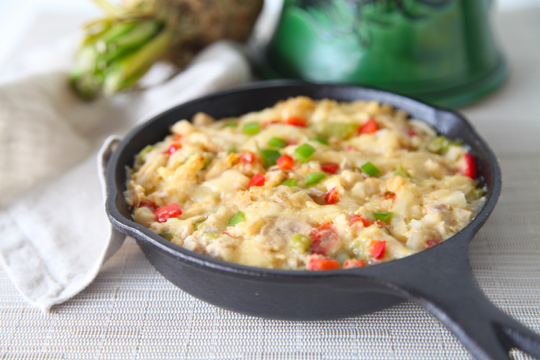



Mark Sisson's Blog
- Mark Sisson's profile
- 199 followers





